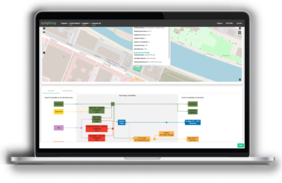
Paradigm shift in energy planning.
The energy industry is changing, traditional planning methods are no longer sufficient to efficiently handle increasingly larger and more complex projects. The trend of moving from centralized to decentralized energy systems is already in full swing and will continue to spread in the energy planning sector. The development of new, holistic planning methods will be necessary to achieve the new goals.
For planners, this means taking a holistic view of energy systems. This requires finding the optimal solutions from a huge selection of technologies and diverse combinations. Furthermore, the range of available solutions is constantly increasing. In addition, energy planners must also ensure grid stability and keep an eye on the economic efficiency of the system.
New approaches for energy planning
The start-up Sympheny helps, through the development of their planning software, to create suitable energy concepts for buildings, districts or entire cities, in order to successfully reconcile sustainability goals with cost requirements. These areas can be grouped into hubs which are then considered either individually or networked.
The Energy hub approach of integrated, multi-energy carrier planning helps to create individual, optimal system designs. This helps to smartly implement the technological innovations related to grid convergence and integrated multi-energy systems.
In such systems, gas, heat, electricity, hydrogen, and other energy carriers can be converted, stored, and the diverse energy flows can be coordinated on site to increase system efficiency.
Web tool for successful planning
The cloud-based web tool provides a way to quickly and cost-effectively identify the optimal energy system.
The platform considers a variety of factors, such as the renewable energy that can be used at a specific site, the different energy needs, and the available technologies. This takes into account the overall goals of the design, whether that is to reduce CO2 emissions, expand on-site renewables, or reduce the overall cost of the system. Thus, the online tool finds the optimal solution for the design of the energy system. This creates the possibility to quickly evaluate a variety of different systems in the overall context. Furthermore, components can be added which are not considered in conventional planning methods.
Cutting-edge research for a promising product.
Before the start-up was founded, many years of research on the topic of optimizing decentralized, renewable energy systems had already been conducted in the research group "Urban Energy Systems Lab, of the renowned Swiss research institute EMPA. The knowledge and methods gained from this research were then incorporated into the development of the tool, thus creating a link between the scientifically developed optimization algorithms and direct application to specific projects.
Practical relevance through strong partnerships
The potential that Sympheny unleashes has already been proven in several reference projects with energy suppliers and engineering firms. Whether it is the creation of an overall plan to achieve the net zero target for a city, the conceptual design of large, CO2 neutral, development projects or the mapping and optimization of projects for the conversion of former industrial sites. Due to the continuous further development of the software, customer requests are directly integrated as features to streamline the planning processes and also to make the use of the data in the planning as smoothly as possible.